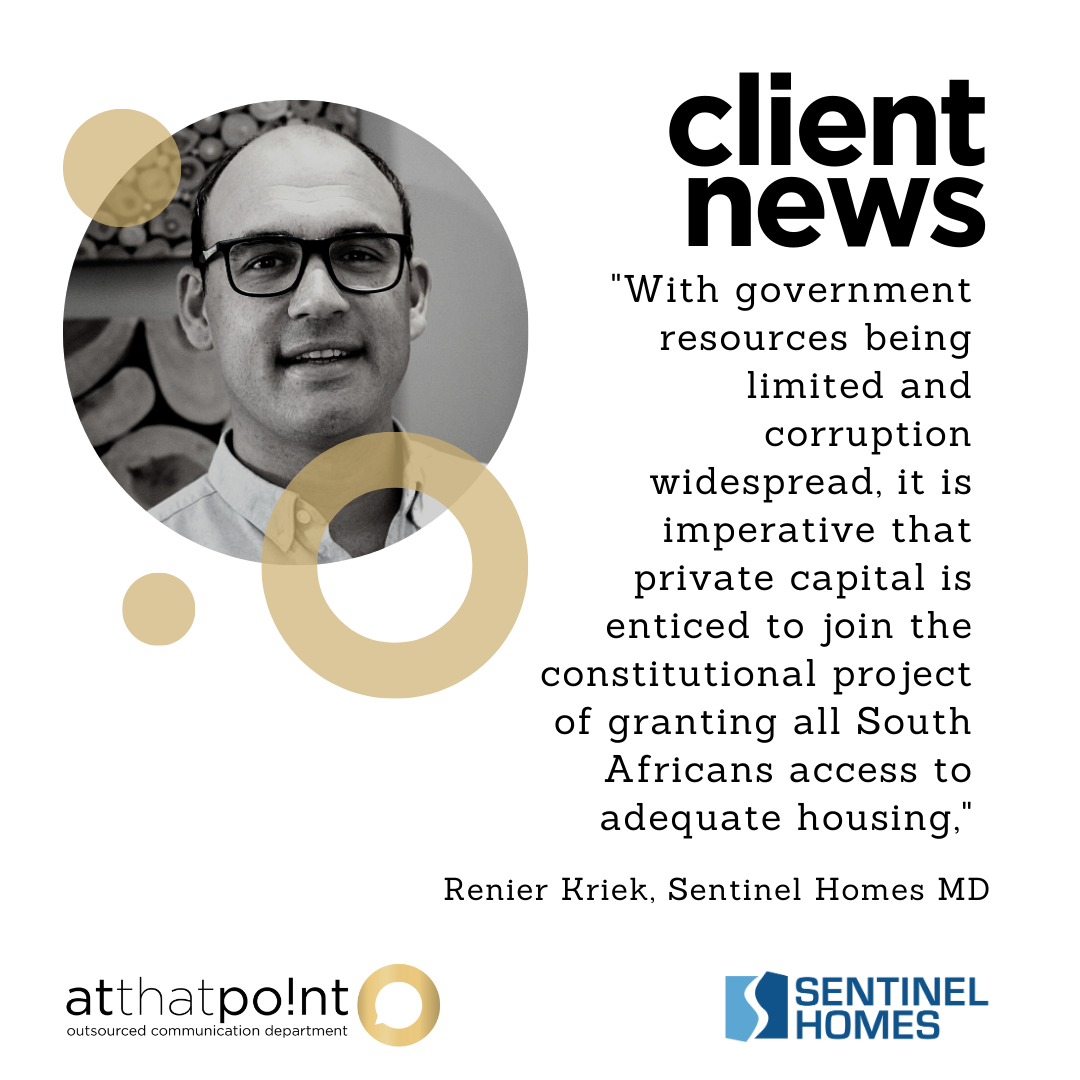 Overregulation of the housing market in South Africa is discouraging the private sector from investing in formal low-cost housing projects. This is according to Renier Kriek, Managing Director at Sentinel Homes. "With government resources being limited and corruption widespread, it is imperative that private capital is enticed to join the constitutional project of granting all South Africans access to adequate housing," he says. It is apparent that, for all the government's initiatives, programmes and subsidies to provide RDP housing, a vast number of underprivileged citizens still reside in informal settlements. However, while tax breaks exist for new or improved rental housing, with added incentives for low-cost housing, the rest of the legal and policy landscape is much less persuasive to investors. Mortgage risk For one, housing consumers who earn less than R15,000.00 per month make up less than 0.6 percent in value and 1.7 percent in number of accounts granted mortgages in Q1 2023, matching a decade long trend. This is because banks tend to avoid these riskier applicants, even when supported by the government's Finance-Linked Subsidy Programme (FLISP). The reason is simple: the excessively long and inefficient foreclosure process in South Africa seems bent on ensuring losses for both banks and defaulting consumers. In addition, judges are often overly sympathetic to defaulting debtors per case, not considering the overall negative effect this has on banks' attitude towards financing the larger underprivileged community. "However, if the cost of terminating defaulting mortgages were low, banks would be less risk averse, thereby increasing the likelihood of access by this segment," says Kriek. Rental risk Similar to mortgages, the time and financial costs of eviction are too high, and the law and courts too lenient on defaulting renters. With the supply of formal housing being so low, the cost of eviction should also be low and the rights of a large number of potential tenants should weigh more heavily than those of a few non-paying tenants. "If the risk was low, more landlords would emerge to invest in satisfying the obvious demand for affordable accommodation," says Kriek. Development rules Lastly, housing development in South Africa is inhibited by long or delayed regulatory processes, as well as building standards designed around first-world circumstances. This is further exacerbated by municipal inefficiency, which affects delivery of essential services like roads, water, power and sanitation. Authorities have also suddenly become deeply concerned with the lack of affordable housing. Their response has been to request that developers include affordable housing units in new developments, even in areas not marked for such housing. "While laudable at first glance, this does not increase the availability of affordable housing as beneficiaries will often flip the unit at market price to realise a profit," says Kriek. The positive intent is therefore negated and leaves the market worse off. Change Is Needed Mortgage risk, rental risk and misguided development rules, taken together, disincentivise the development of low-cost housing in favour of larger, pricier units. "Given the state of the country’s housing market, urgent legal reforms and business-friendly policies are needed to ensure all South Africans gain access to constitutionally mandated housing," says Kriek. ENDS MEDIA CONTACT: Rosa-Mari Le Roux, [email protected], 060 995 6277, www.atthatpoint.co.za For more information on Sentinel Homes please visit: Website: www.sentinelhomes.co.za Facebook: Sentinel Home
0 Comments
 South Africans who have been hesitating to buy a new home due to high interest rates may finally be able to take the plunge. "For the first time since April 2022, the Consumer Price Index (CPI) has fallen back within the Reserve Bank’s target band of between 3-6 percent," says Renier Kriek, Managing Director at Sentinel Homes. According to Kriek, a lower CPI indicates that inflation has potentially peaked. This will likely mean stabilization of the market interest rates and a repo rate reduction could even be on the way. Signs that inflation is falling Since the disruption to world economies caused by COVID-19, several factors subsequently contributed to high global inflation, from which South Africa was not spared. Inflation often occurs because the difference between consumer demand for items and producers' ability to supply them causes their prices to increase too sharply to remain affordable. It may also result from a drop in the relative purchasing value of money due to various economic factors. Inflation in South Africa is measured through the Consumer Price Index (CPI) compiled by Stats SA. The South African Reserve Bank (SARB) follows a policy of keeping any changes in the CPI within a range of 3 to 6 percent year-on-year, preferring to keep it anchored at 5 percent. Even before local CPI breached 6 percent earlier last year, SARB moved to reign in inflation with 10 consecutive increases in the repo rate, to the current level of 8.25 percent. Interest rates consumers are charged on their debt, such as the prime rate, are linked to the repo rate. This means that rises in the repo rate makes repayments on debts like home, car and personal loans more expensive, forcing consumers to curb non-essential purchases and bringing rampant price increases down. However, on 21 July 2023, the SARB's Monetary Policy Committee announced the repo rate would stay unchanged at 8.25 percent, saying it remains cautious. The main reason a further increase was avoided is the drop in the CPI from almost 7 percent in April to only 5.4 percent in July. The July CPI was even lower than what economists predicted. "For consumers, this means that, barring unforeseen increases in inflation, the repo rate will remain steady and might even be reduced in September, when the Committee meets again," says Kriek. Are there homes to buy? The South African economy created 1.2 million new jobs between the first quarter of 2022 and the first quarter of 2023, despite challenges like inflation, loadshedding and poor service delivery. If the repo rate drops as expected, this will put even more money in people's pockets and boost economic activity. In short, things are looking up for South Africans, especially those with their hearts set on buying a home. Although estate agents report a shortage of stock from resilient homeowners desperate to keep their properties, home loan debtors are clearly facing heavy stress from current high interest rates. The National Credit Regulator reports that while the number of mortgages not in arrears are usually around 91 percent of total home loans, the first quarter of 2023 saw a drop to 88.85 percent. The arrears rate has steadily increased as interest rates climbed higher. "Banks will likely be eager to help owners in arrears with payments start the process of selling those properties, meaning we are likely to see increased stock coming onto the market soon,” says Kriek. “The normal stock cycle in the property market will also return if sellers see positive signals, such as stagnation or decline in interest rates. Until that time, sellers are likely to hold out on selling as much as they can to avoid being price takers.” Is it time to buy? Of course, the best time to buy depends on various factors and conditions, changing from region to region, case to case and price range to price range. However, Kriek says for anyone set on semigrating from the northern provinces to the Western Cape or elsewehere on the coast, the time is ripe to buy and they should not wait. Properties selling against home loan debt typically carry an average sales value of around R1.3 million. Properties at this price point and anything below the average price have seen and will continue to yield a respectable return on investment. “Demand very clearly outstrips supply for properties priced below the average,” says Kriek. The exception is properties in the very high range, above R4 million. "I see evidence that prices will come down further so it may be best for prospective buyers in that price range to bide their time until the market bottoms out,” says Kriek. “Of course, there are exceptions, such as Sea Point or Stellenbosch.” Lastly, Kriek advises that, with interest rates having peaked, purchasers should opt for a variable interest rate instead of a fixed interest rate. "Homeowners taking advantage of the eventual drop in the repo rate can enjoy their property while reducing their bond repayments," he says. ENDS MEDIA CONTACT: Rosa-Mari Le Roux, [email protected], 060 995 6277, www.atthatpoint.co.za For more information on Sentinel Homes please visit: Website: www.sentinelhomes.co.za Facebook: Sentinel Homes  Homes farther out, and more reasonably priced. This is increasingly what South African property buyers are looking for. “There are multiple reasons contributing to this trend,” explains Renier Kriek, CEO of home financing company Sentinel Homes. "Rising interest rates and the resulting decline in transaction volume are significant factors. The increased proportion of ‘motivated sellers,’ selling because they are in a rising costs squeeze, are now likely to stabilise price growth until the rate hiking cycle eases off or starts to reverse.” According to Kriek, the consequences of the Covid-19 pandemic are also still very visible. “Office vacancy rates have increased, resulting in consumers no longer being as motivated by office proximity when selecting homes. This means they can search for value in outlying areas. Many even semigrate to other parts of the country. We also expect to see a rising level of commercial to residential conversions in urban areas. Semigration and its cousin convenience Kriek names the current hottest markets and sites for real estate investment as the coastal regions from the West Coast to Cape Town and Mossel Bay. “The Mother City remains very popular despite high prices and strained infrastructure,” he says. “This thanks to their loadshedding buffer due to the City’s generation projects and other electricity initiatives, as well as the city’s lifestyle benefits.” He claims that the Garden Route and George Airport’s close proximity make this popular tourist destination just as convenient as Cape Town. “But it must be highlighted that the affordability benefit there is quickly waning because this area has become a focus for immigrants from both inside and outside the Western Cape.” Finally, the West Coast (north of Cape Town) is also seeing a rise in the real estate market, thanks to its charming tiny fishing villages and rural communities like Langebaan, St Helena Bay and Paternoster. “Consumers who work from home are discovering the real value in pricing that was previously only influenced by variables connected to the regional fishing and farming industry. Due to external demand for property, it is now unbound. On the other hand, gentrification problems may result from this and increasingly poor access to housing for families in the bottom half of the income spectrum is a real threat.” Kriek says those still buying property in the economic hub of Gauteng, are shying away from freehold properties, such as single houses on larger plots in unguarded neighborhoods. “They prefer estates and sectional schemes. This is likely a search for safety and services,” he elaborates. Those entering the Gauteng property market will likely find the best long-term investment to be inside a security estate or secured sectional title scheme. Owners of freehold properties in more traditional suburbs may consider cashing out and moving with the trend in the interest of their longer-term financial well-being.” Challenges for First Time Buyers Kriek says that first-time buyers - who make up a very large proportion of purchasers - are moving into the property market much later. This trend is continuing to intensify. The lack of affordable housing supply and inefficient housing finance market in the affordable or gap housing market, specifically properties priced under R750 000, contributes significantly to this trend. “The National government, through the Department of Human Settlements, unveiled significant updates to their Finance Linked Individual Subsidy Programme (FLISP), now called First Home Finance, with the aim to improve access to affordable and gap housing. The expanded policy is still in the nascent stage of implementation, however, and its effects are likely not to be evident in market trends until next year.” Kriek adds that Sentinel Homes offers the first open-market alternative to mortgages. By expanding access to housing finance, it is serving those 5%-10% of housing consumers who lack housing finance, despite being creditworthy and having the necessary disposable income. “Now is the time in the property market cycle to escape the rent trap and start meaningful steps toward long-term financial health. Homeownership is a significant part of that equation,” says Kriek. “You are more likely to buy something you can really afford if you buy it in the current conditions. There is the added upside that prices for properties priced around the average can only really go one way from here – and that is up!” ENDS MEDIA CONTACT: Rosa-Mari Le Roux, [email protected], 060 995 6277, www.atthatpoint.co.za For more information on Sentinel Homes please visit: Website: www.sentinelhomes.co.za Facebook: Sentinel Homes  It's not easy to get a mortgage on your dream home if you're not employed full time and earning a fixed salary. Freelancers, those working on commission or sourcing their income from gigs, and many other independent earners, often find themselves facing a brick wall when applying for a home loan from banks. However, more people than ever are becoming self-employed in these fields and are seeking easier alternatives to a traditional mortgage bond. This is according to Renier Kriek, Managing Director at Sentinel Homes, which specialises in financing home ownership through instalment sale agreements. How does it work? "Instalment sale agreements are steadily becoming popular not just among those that do not qualify for a bond but also many who do not fit the salaried mould for which the mortgage model was specifically developed," says Kriek. An instalment sale makes acquiring a home similar to buying a vehicle on hire purchase. In Sentinel's case, the company finances the purchase and the buyer repays the value of the property in monthly instalments. Although the company holds the title deed, the buyer enjoys all the rights and responsibilities of ownership during the period of the contract. Once the purchase price is repaid in full, total ownership is transferred to the buyer. "On the surface, there is little difference between buying with a bond or via an instalment sale," says Kriek. “The only practical difference is the procedure followed when the buyers do not pay their instalment, but even in that case, an instalment sale is to their advantage.” However, an instalment sale agreement offers several advantages to this class of homeowner. Improved affordability Because a freelancer or a self-employed person’s income may vary from month to month, the bank will only consider a portion of their earnings. So, even if they qualify for a home loan, they will likely have to settle for a cheaper property or fund any shortfall on the purchase price themselves. Through an instalment sale, up to 100% of their income is assessed. “This gives the purchaser more freedom to choose a property they really want,” says Kriek. Improved credit score An instalment sale allows a buyer to acquire a valuable asset sooner and improve their credit score in the process. As the property’s value increases and their financial position grows over time, they may become a more attractive borrower. And they do not risk being caught in a rent trap while the values of homes continue to increase. "Many of our clients have been granted bonds on the basis of their instalment payment history and were able to settle our instalment agreement early from bond refinance," says Kriek. Lower default risk When a borrower defaults on their mortgage, they face losing their property through a sheriff’s auction, having adverse judgements against them, and being blacklisted for 5 years or more. This impedes their ability to acquire another property and obtain any credit, and may even limit employment opportunities. However, with an instalment sale agreement, they have more options, including negotiating their position and, ultimately, selling the property to pay off their debt. "Even then, they retain a clean record and we have assisted clients that eventually recovered from such a position to buy another property," says Kriek. Protected by law As with a mortgage, the contract is governed by the very comprehensive National Credit Act. Another law, the Alienation of Land Act, also applies, ensuring the rights of the parties to the agreement are fully protected. Instalment sales are also registered against the title deed of the property. A growing market As more people start to freelance or work in other independent fields with irregular income, owning a home through an instalment sale agreement promises a logical alternative to mortgage bonds. "It is apparent that an instalment sale agreement offers better advantages, more protection and greater flexibility to those who dream of owning a home without sacrificing their financial independence," says Kriek. ENDS MEDIA CONTACT: Rosa-Mari Le Roux, [email protected], 060 995 6277, www.atthatpoint.co.za For more information on Sentinel Homes please visit: Website: www.sentinelhomes.co.za Facebook: Sentinel Home |
Welcome to the Sentinel Homes Newsroom. BROADCAST INTERVIEWS2023 Archives
July 2024
Categories
All
|

 RSS Feed
RSS Feed